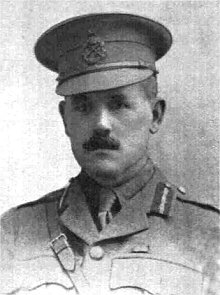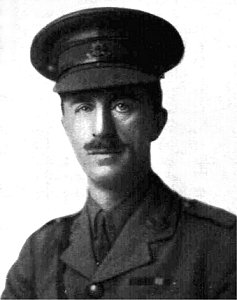2nd Battalion Worcestershire Regiment - 1914
The order for mobilisation was received, at Aldershot on the evening of 4th August 1914, and during the ensuing week all ranks of the 2nd Battalion Worcestershire were busily employed in completing their preparations for War. The Battalion had to be filled up to war strength by reservists, weapons had to be made ready, equipment and ammunition received and issued, stores of all kinds taken into use. Officers and men had to be medically inspected and passed fit for service, additional horses had to be received and taken over, regimental property had to be placed in safe keeping.
Most precious of all, the Colours of the Battalion, the symbols of their history and of their loyalty, had to be laid away. They were taken to Worcester by special escorts and handed to the care of the Dean and Chapter to be preserved in the Cathedral until the Battalion should need them.
Worcester, when the Colour Party came, was seething with activity. The Depot at Norton Barracks was crowded out with reservists and with volunteers for service, who were sleeping all over the cricket ground and the adjoining fields.
During the second week in August the mobilization was completed. Then for some days the Battalions stood fast awaiting orders — days of tense excitement and speculation while the Reservists were settling down and while everything was in the state of general disorder and discomfort which always precedes a move.
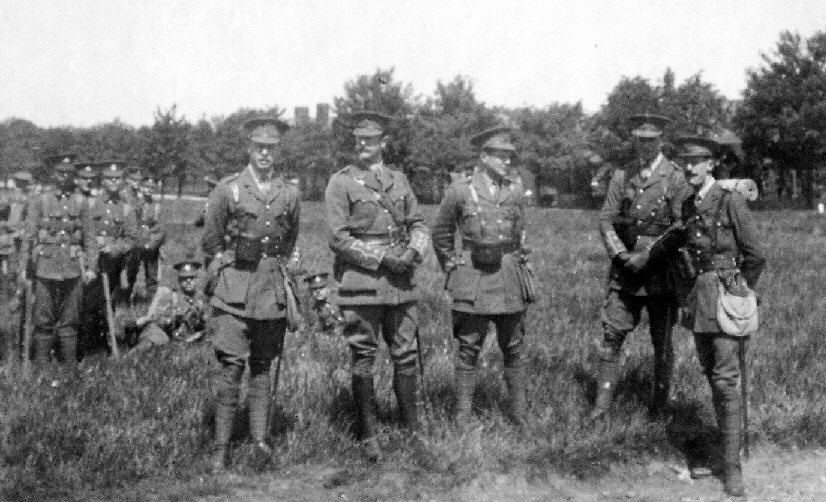
2nd Battalion Worcestershire Regiment - Officers of 'D' Company (1913-1914)
L to R: Lieut. F. E. Middleton-Gavey, Captain Gerald E, Lea, 2/Lieut. H. P. Hartnoll, Lieut. R. E. Vyvyan, Captain J. P. L. Stoney
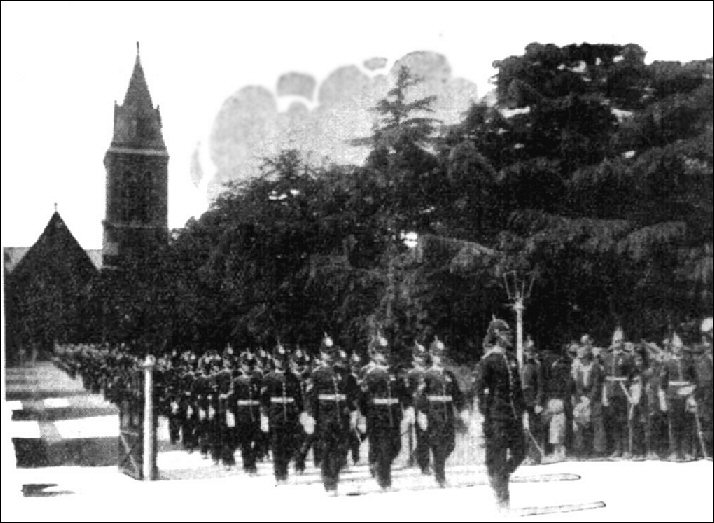
The last Church Parade of the 2nd Battalion at Aldershot in 1914
Captain G. E. Lea seen here at the head of the Battalion, was to die of his wounds at Tilleul Heights (The Battle of the Aisne) on the 15th September 1914
The Concentration in France
No formal alliance had existed before the War between England and France, but the development of the "Entente" had resulted in certain arrangements for concerted action if the necessity should arise. It had been arranged that such troops as might be sent from England to France could operate as a more or less independent force but no fixed plan had been made before the War, and no definite decision was made until 6th August 1914. Then the British Government decided to dispatch a force of four Divisions and one cavalry Division. Subsequently it was decided that this force should be concentrated in the area south-west of the frontier fortress of Maubeuge, on the left or northern flank of the long French battle-line. The movement of the British Expeditionary Force to France began on the 9th August 1914, and was conducted with such secrecy and efficiency that for several days the move remained unknown to the enemy. The 2nd Battalion Worcestershire received their orders on the 12th August 1914. Early on the morning of August 13th the 2nd Battalion marched down to the Government siding at Aldershot and entrained. The two trains which carried the Battalion left Aldershot at 7 a.m. and 8 a.m. respectively and three hours later arrived at Southampton Docks. The two half-battalions were embarked on board the transports "Lake Michigan" and "Herschel." All the rest of that day the ships lay in Southampton Docks. Not until after nightfall did the first of the two transports sheer off and steam down the quiet Southampton Water, past the darkened lights and the patrolling torpedo boats, out into the Channel. The officers who embarked for France with the 2nd Battalion were :— Other ranks 977, including 48 sergeants. In addition, the following officers of the Regiment went out with the Staff of the original Expeditionary Force:— Major G. J. Farmar, Major A. D.Green, D.S.O., and Captain F. P. Dunlop. In the afternoon of the following day (August 14th) the “Lake Michigan” entered the harbour of Boulogne. The half-battalion disembarked and marched through the narrow cobbled streets to a prepared rest camp, the "Camp de Marlborough," on the hill above the town. The British troops were enthusiastically received by the populace and by the French Territorial battalions guarding the port. Three hours later the "Herschel" likewise came into Boulogne, and the second half-battalion joined the leading companies. |
Lieut.-Colonel C. B. Westmacott
|
Major E. B. Hankey |
All next day the Battalion lay in the camp on the hill amid constant bustle and stir of troops arriving. In the evening the lines of the Battalion were visited by Field-Marshal Sir John French and by the French Commander-in-Chief, General Joffre.
Close on midnight (August 15th/16th) the Battalion paraded and marched down to sidings near Boulogne Station, where they entrained and were carried eastwards to the concentration areas.
The 2nd Battalion, in the 2nd Division, next experienced a crawling train journey from Boulogne through Amiens and Arras to Wassigny, the Battalion marched six miles to Lesquielles St. Germain. The troops reached their destination long after dark, August 16th, but never the less met with a most cordial reception from the inhabitants on whom they were billeted.
The 2nd Battalion then stayed in their billets during four days, which were crammed full of training, inspections, and practice marches. It was hot, very hot, and the troops, while daily getting fitter, probably did not then fully appreciate the benefit conferred.
Early on August 21st the 2nd Worcestershire marched via Etreux to La Groise. There for the first time the Battalion had to find outposts — on the bridge at Catillon over the River Sambre.
Next morning (22nd) the 2nd Division marched from La Groise by way of Landrecies to Pont-sur-Sambre. There the troops rested and bathed, this was to be the last chance they were to have of either luxury for many a long day.
At 1 a.m. on August 23rd the Battalion was roused and assembled in the dark, only to spend a long hour waiting in the road while other troops got into position. Before dawn, the Division moved off, crossed the Belgian frontier and marched through Malplaquet. They arrived at Bougnies shortly after midday and heard for the first time the distant thunder of guns.
The Battle of Mons
While the British Expeditionary Force had been concentrating in the area around Mons, the oncoming German armies had been advancing rapidly westward through Belgium towards the French frontier. Already the defending Belgian army had been forced to withdraw northwards upon the fortifications of Antwerp. The original intention had been that the British force, together with the French Fifth Army, should co-operate with the Belgians; hut the German advance had dislocated the plans of the Allies, and, as a temporary measure, orders had been issued for the British Expeditionary Force to take up a defensive position along the line of the canal which runs eastward from Condé to Mons. Little was known as to the strength or plans of the enemy; so the British position was organised in depth, with strong supporting positions on which the front line could fall back if hard pressed.
That precaution soon proved to have been wisely taken; for it became evident that the enemy were about to attack in force. German cavalry had come in contact with the British outposts on August 22nd. Early on the morning of Sunday, August 23rd, German artillery opened fire and, by the time that the two Worcestershire battalions came up, the British front line was hotly engaged.
On the right of the British, the French Fifth Army in its position about Charleroi was already sustaining the attacks of the German forces. Between the French left and the right of the British was a gap of some seven miles. Then the British Army was aligned, the 1st Division on the right and then in succession the 2nd, 3rd, and 5th Divisions. The areas allotted to the 2nd and 3rd Divisions had overlapped, the latter being in front. A readjustment was in progress, orders had been given for the 2nd Division to relieve the right flank of the 3rd Division, and delay of some two hours ensued before the battalions of the 2nd Division were ordered forward. As the 2nd Battalion Worcestershire waited by the roadside, battery after battery of artillery galloped past them and the artillery fire in front grew more intense.
2nd Division Headquarters had been established at a crossroads on the Mons-Maubeuge road and about 4.30 p.m. the 5th Brigade were ordered to take up a defensive position in front of that crossroads. The 2nd Battalion dug in across a field, on the forward slope of a gentle rise. From their position they could see the shells bursting over Mons. Houses were burning there, and the flames lit up the sky as dusk came on.
The retirement of the British front line troops on to their supporting second line had been previously planned. However, in the confusion of battle, the brigades on the inner flanks of the 3rd and the 5th Divisions retired in rather divergent directions, leaving between them a gap in the line about the villages of Paturages and Frameries. The enemy had been hard hit and did not closely follow the British withdrawal. Nevertheless the existence of that gap in the line was dangerous, and an urgent message was sent for reinforcements to close the breach. To meet that emergency, orders were issued for the reserve brigade of the 2nd Division to move at once to the threatened point and reinforce the 3rd Division. The Brigade thus selected was the 5th Brigade, which included the 2nd Battalion Worcestershire.
Accordingly, just as the trenches of the 2nd Worcestershire near Bougnies seemed to be nearing completion, orders came down the line for the men to stop work and fall in on the road. There the position was explained, additional ammunition was issued, and all made ready for attack; then, after the delay inevitable in assembling in the dark, the force moved off, the Worcestershire leading, followed by the Oxfordshire Light Infantry and the Highland Light Infantry, the fourth battalion of the Brigade, the 2nd Battalion Connaught Rangers, was left to hold the previous position. By that time the troops were dog-tired and at every check in the march they promptly fell asleep where they stood. The battalions moved through the night down the road with bayonets fixed, the officers with their revolvers ready, expecting at any moment to meet the enemy’s fire. But when Frameries was reached, about 1 a.m., the village was found to be unoccupied. The enemy had not advanced.
Frameries proved to be an ugly mining village with slagheaps and tangled streets. The ground north of it was an open slope. There the 2nd Battalion Worcestershire deployed, while the two light infantry battalions went on further to complete the line from Frameries to Paturages.
The defensive line selected for the 2nd Battalion Worcestershire ran across a wide stubble field. All ranks of the Battalion were already tired out, but all worked hard at the entrenchment of the new position, and by great efforts the necessary cover was completed just before dawn August 24th.
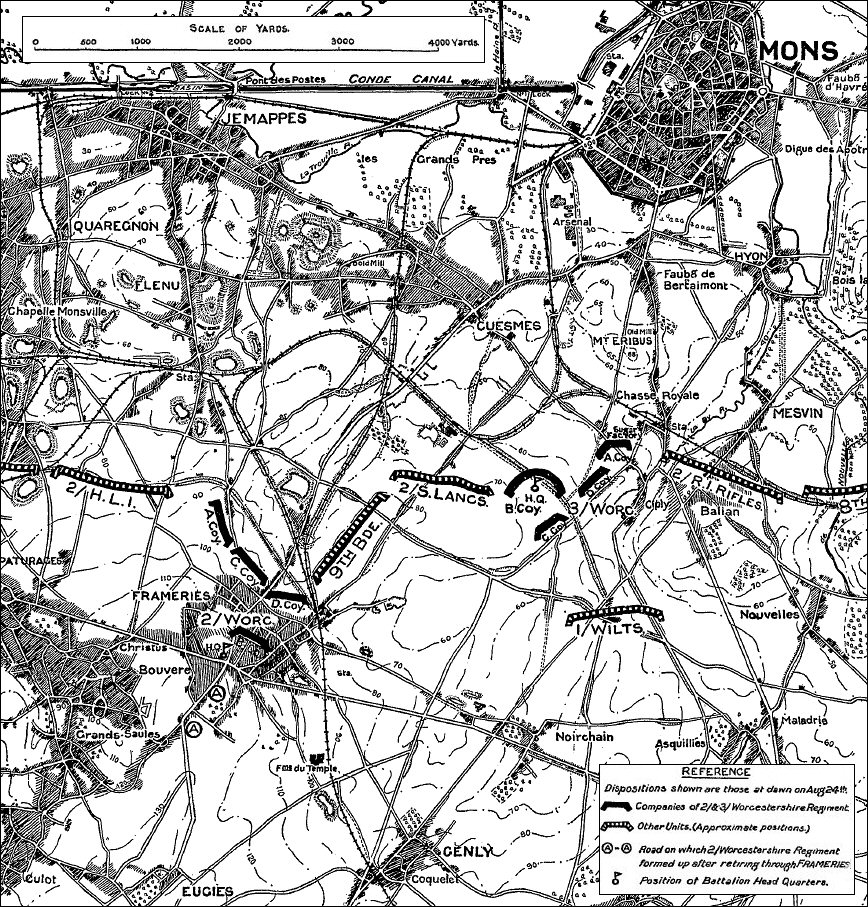
Situation at dawn on the 24th August 1914
(the circled 'A' shows the road which the formed up on after retiring through Frameries)
At the first light the enemy’s attack was renewed. The German guns opened fire, and soon shrapnel was bursting all along the British line. One of the first shells killed the horse of the Adjutant, Lieut. B. C. Senhouse Clarke, this was actually the first loss in the Battalion. Presently small bodies of the German infantry were seen advancing among the slagheaps and cottages of Flenu and Cuesmes.
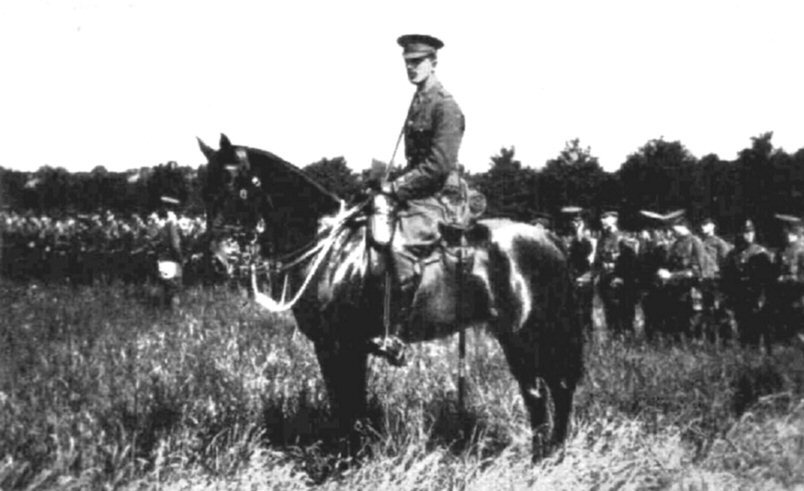
Lieutenant and Adjutant B. C. Stenhouse Clarke
(seen here on the horse that was killed by a shell)
The enemy did not come on very fast. On the previous day they had advanced boldly and had suffered severely from the British musketry. They had learnt caution and they now advanced with circumspection towards the positions of the British battalions. These latter held their ground, opening fire at intervals when suitable targets were offered.
The enemy’s shellfire caused several casualties among the 2nd Battalion Worcestershire. One severely wounded man was carried in to safety by Company-Sergeant-Major A. Mayston (C. S. M. Mayston was subsequently awarded the D.C.M. The D.C.M. was also awarded to Cpl. R. Baldwin and to Pte. J. W. Banner for bravery during the fighting at Frameries). Another was rescued by two stretcher-bearers of the Battalion, who came up to the bombarded trenches from the houses in rear across the open, winning general admiration for their contempt of danger. The bombardment became even more severe, but the enemy’s infantry remained at a respectful distance, and no serious attack had yet developed when, about 8 a.m., came orders to retire.
Away on the right at Charleroi the French Fifth Army had been driven from its position. That information had been communicated to British General Headquarters about midnight together with the news that the attacking enemy were stronger than had been supposed. Actually against the four British Divisions eight German Divisions were engaged, of which six were concentrated against the two Divisions of the British 2nd Corps. Such odds could not indefinitely be withstood. To avoid destruction the British force must withdraw, and in the early hours of the morning of August 24th orders for that withdrawal were issued.
The retirement of the 3rd Division, to which the 5th Brigade was now attached, was to be carried out in two stages. First the 5th and 9th Brigades were to fall back to a position in more open country clear of the villages, then the 7th and 8th Brigades were to conform by falling back in their turn.
The order to retire reached the 2nd Battalion, about 8 a.m. Messages were sent forward to the trenches that the companies were to retire in succession through Frameries village and were to form up south of the houses. In accordance with those orders the companies left their trenches and fell back through Frameries.
As the troops fell back, the wretched inhabitants of the village poured out of their houses in a terror-stricken mob. In the streets all order was lost. Runaway horses and shrieking, sobbing women broke up the ranks of the platoons, while the houses around collapsed under the German shells. But the Worcestershire lads kept their heads. Orders were shouted to reform on the road beyond the village, and officers and men made their way as best they could through the stampede.
On the road south of the village the companies were halted and reassembled. As if on peace training the platoons closed up into column of fours and stood at ease. Rolls were called and every man was accounted for. The troops were cool and steady, in spite of the shells bursting among the houses close behind. When all was ready the Battalion sloped arms and marched off down the road, "exactly as if marching back to barracks at Aldershot." "I have always considered," said an officer who saw much fighting afterwards, "that this reassembly of the Battalion after the utter disorder in the streets of Frameries was the finest possible example of the discipline of the ‘Old Army.’ "
The Battalion marched back about a mile to the outskirts of Eugies and there took up a position to cover further retirement. The 2nd Battalion Oxfordshire and Buckinghamshire Light Infantry took up position on the left of the 2nd Battalion Worcestershire, and presently the 1st Battalion Lincoinshire fell back into line on the right flank.
The 2nd Battalion Worcestershire remained at Eugies until about 4.30 p.m. when orders came to rejoin the 2nd Division. The Brigade moved off and, after a tiring but uneventful march, reached Bavai about 10 p.m.. The 2nd Worcestershire bivouacked for the night in an open field, cheered by a hot meal and a welcome mail from home.
That night important decisions were made. To the southward the French armies were in full retreat. To the northward German forces were advancing to envelop the British left flank. A further retirement was inevitable, but the organisation of the withdrawal was difficult; for in rear of the centre of the British line lay the great Forest of Mormal, a difficult obstacle for large bodies of troops. Consequently it became necessary to divide the British force: the 1st Corps, including the 1st and 2nd Divisions, was ordered to retreat down the eastern side of the Forest while the 2nd Corps, the 3rd and 5th Divisions, was to march southwards along its western edge. Orders to that effect were issued from Headquarters during the evening, but it was not until after midnight that the Battalions were told that at dawn they were again to retreat.
At dawn on the morning of the 25th August 1914, the retreat was commenced, and the 5th Brigade marched back to Pont-sur-Sambre. There, about 11 a.m., a halt was made and the Battalion spent much time and energy in preparing the little town for defence -- knocking loopholes in the walls of houses and entrenching a roadway. While they were working, long straggling columns of French infantry poured back through the place. The defences were nearing completion and the men’s dinners were nearly cooked when about 5 p.m. orders came to retreat again at once to Noyelles. Defences and dinners alike had to be abandoned: the Battalion set out and marched down the road side by side with a French battalion "all very keen and jolly," wrote one of our officers, "and longing for ‘la revanche’ ". At Leval an alarm was created by a daring patrol of German cavalry, which fired into the column of transport ahead of the Battalion, causing some panic and much wasted time in a futile deployment. In consequence of that delay it was not till 10.30 that the Battalion reached their destined bivouacs at Noyelles. There, wrote a subaltern, "I got some cocoa and bully and got quickly into my valise when suddenly a message came ordering us to return at once to Pont-sur-Sambre."
That order was the result of German night attacks on the rearguards of the Division, then at Landrecies and Maroilles.
In the midnight darkness the weary Battalion fell in and, with bayonets fixed, tramped slowly back. Leval had nearly been reached when the Divisional General’s car came by, with instructions for the Battalion to wait and sleep till further orders.
The enemy’s attacks had not been pressed, and as the light of dawn (Aug. 26th) showed in the east the Battalion fell in and again marched southward. The Worcestershire formed in theory the advanced guard of the Brigade, the rearguard being formed by the Connaught Rangers. But in practice the Battalion was isolated and the location of Brigade Headquarters was unknown. "We were all dog-tired," wrote an officer, "and when we halted at Marbaix for half an hour we were all sound asleep on the road." That halt was caused by a French column cutting into the line of march, causing great confusion. Orders then came for the Battalion to proceed to Barzy.
A most trying march ensued. The roads were crowded with terrified refugees and with disordered columns of French infantry and guns. The weather was sultry and the men were tired out and hungry. Away to the westward could be heard a distant thunder of artillery, the thunder of the battle of Le Cateau. Closer at hand an intermittent gun-fire behind them told of enemy pressure on the rearguard, the hapless Connaught Rangers, who on that day lost their Colonel and three hundred men.
After many delays the Battalion reached Barzy at dark. There they were joined by the Oxfordshire Light Infantry. The situation of the rest of the Brigade was unknown. Both battalions slept the sleep of exhaustion till midnight, when they were again aroused. Reports had come in from the French that the enemy were close at hand, and the two Battalion Commanders decided that there was no course open but at once to resume the retreat. At dawn (Aug. 27th) the two battalions reached Boue, where the Brigade Staff was met and the men had two hours rest. Then on to Etreux. There at last it was possible to get some food. There too was the remainder of the 2nd Division. Leaving Etreux at 9.30 the Battalion marched with the Division through Guise to Mont d’Origny where, shortly after dark, billets were found. One company, "D", was left behind as outposts and did not get in till 10 p.m.
Early on the 28th August 1914, the 2nd Battalion was aroused, and fell in at 4 a.m. This time the 2nd Division marched closed up in one column, its rear protected by the 1st Division, and the sound of gunfire was far distant. But the day was very hot and the incessant strain was telling on the physique of the troops. All along the line of march men fell out in hundreds. Through La Fére the column struggled, through Danizy to Servais, where at last the weary troops found good billets and a rest. All the next day the Battalion lay quiet, while gradually the stragglers came in. The men slept and washed, "the first time for a week," noted a subaltern, "that we had our clothes off."
After a day of rest at Servais the 5th Brigade resumed the retreat on the morning of the 30th. The 2nd Worcestershire left their billets at 3 a.m. and marched southwards through lovely wooded country along cruelly rough roads. The day was intolerably hot; so hot indeed that a halt from 11.30 to 1.30 was necessary. After passing through Coucy-le-Chateau, the Brigade finally came to rest at 5.30 p.m. at the village of Terny.
Starting again at 5 a.m. on the following day the Brigade marched to Soissons and saw for the first time the river and valley of the Aisne. At the Pommiers bridge a long delay was caused by a mistaken order given to the Brigade transport. Finally the Brigade was diverted to Laversine, where the Battalion went into bivouac.
At 2 a.m. on the 1st September the 5th Brigade resumed its retreat and maiched from Laversine into the forest country to the southwards. Through Soucy the column marched to Villers-Cotterets. There the Brigade passed through the entrenched position taken up on the previous day by the 4th (Guards) Brigade to check the enemy’s pursuit. The leading troops of the German advanced guard came into action against that position about 10 a.m. and a sharp fight ensued. As a result of that attack the 5th Brigade received orders to halt and await developments, and for two hours the troops lay in a wood north-east of Villers-en-Potées, listening to the firing. Then came orders to retreat again to Betz. At Cuvergnon the Brigade was again halted and was ordered to take up a defensive position round the village, a position on which the hard-pressed Guards might fall back. A defensive position was taken up, with the Oxfordshire Light Infantry and the Worcestershire in front line and the remainder of the Brigade in reserve behind the village. The troops dug in and were fairly entrenched by dark.
In that position the 2nd Battalion Worcestershire and the Oxfordshire Light Infantry remained throughout the night, while the Guards withdrew into safety and the 2nd Division continued the retreat. An attack was expected at any moment. Orders were that the rearguard was to hold on at all costs until the main body had cleared the bridge at Betz. But no attack developed, the fighting of the previous day had taken the sting out of the German advanced guard, and at 8 a.m. the two battalions filed out of their trenches and withdrew in rearguard formation. They marched through Etavigny, Vincy and Etrepilly to Barcy. There, unknowing, the 2nd Battalion Worcestershire passed within a mile of the 3rd Battalion at Marcilly and pushed on through Penchard to Chauconin, where at 3 p.m. the 2nd Battalion went into bivouac The heat had been appalling, and the troops, tired by the previous night of strain, were much distressed.
Next day (September 3rd) the 2nd Battalion was roused at 3 a.m. and the retreat of the 5th Brigade was resumed. The Brigade marched in an easterly direction, to close a gap, which had opened between the British right and the left flank of the nearest French Corps. The Brigade passed through Meaux at 4 a.m. and pushed on to Trilport, where shortly before 6 a.m. the river Marne was crossed. Onwards the column tramped to Monceaux. There, orders were received for the Brigade to take up a position at Petit Courois. The Brigade proceeded to that point, halted and faced about. The Battalion went into bivouac, and while the troops were engaged in settling down for the night a German aeroplane came over, flying low. Fire was opened on it, and it was brought down, one of the first to be so dealt with.
There followed another day (September 4th) of oppressive heat. The bulk of the 5th Brigade withdrew at 6 a.m. from Petit Courois to another position, near Grand Bilbarteaux Farm, but it was not till 10.15 a.m. that the 2nd Worcestershire, left as rear-guard, fell back to their new position. Late in the evening (8 to 10 p.m.) the 5th Brigade again retired. The direction of march had been changed and the Brigade moved south-westward, marching by the Bois de Morillas to Le Villeneuve. At Morillas the Worcestershire and the H.L.I. faced about in the dark and took up an outpost line facing northeastward. The line of the Battalion ran from the Bois de Morillas to Maisoncelles. The night was one of considerable anxiety to the Battalion Staff. Touch with the 3rd Division on the left had been lost and the whereabouts of the Divisional Cavalry, who might, or might not, be covering the retirement, were unknown. The change of direction had disarranged the work of the Staff, and next morning (September 5th) the orders to retire did not reach the two battalions until over two hours after the rest of the Army was on the move. They were not then able to rejoin the 5th Brigade, but marched back independently in rearguard formation through La Celle, across the Grand Morin river, through Mortcerf and La Houssaye to Marles. There they rejoined the rest of the Brigade, which had marched back by Faremoutiers and Hautefeuille.

